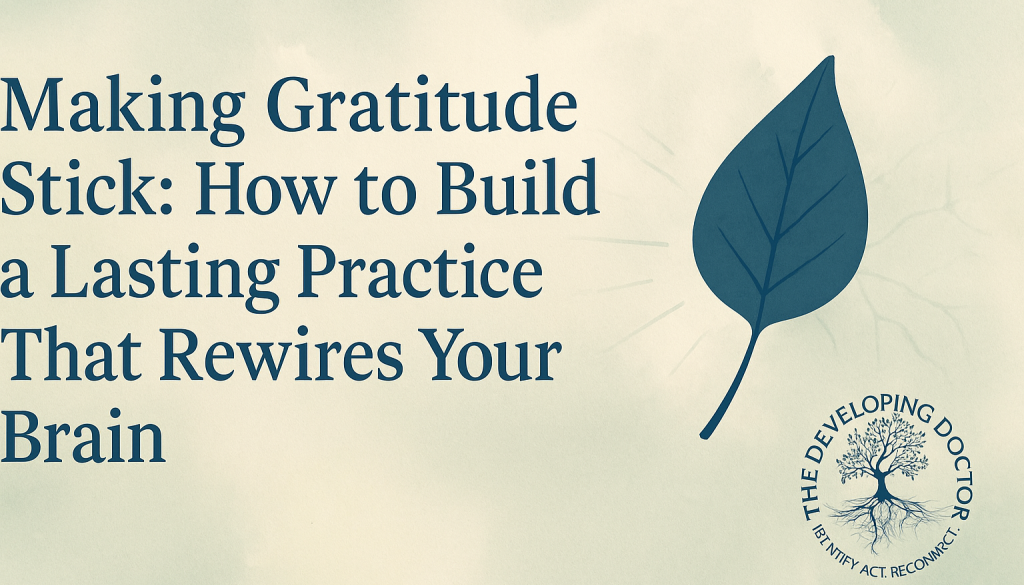Making Gratitude Stick: How to Build a Lasting Practice That Rewires Your Brain
More than a Moment: Making Gratitude Stick.
Gratitude feels great in the moment. You pause, you notice something good, you feel your shoulders drop a little. That short-term effect matters. It can decrease stress, calm your nervous system, and pull you out of the free fall of a rough day.
But there’s a deeper version of gratitude most people never reach.
Long-term, repeated gratitude practice changes how you feel today and how your brain works tomorrow. It literally teaches your brain to notice safety, connection, and meaning more easily, and to come down from threat mode faster.
Think about that for a minute. A few minutes of gratitude practice changes your brain!
That’s the difference between “I felt a little better after I did it once” and “I am different because I keep doing it.”
This is the part that interests me most as a physician, a coach, and, honestly, someone who has been tired before.
So, if you want to rewire your brain to notice more of the good in a world that likes to focus on the worst, keep readin.
Short-Term Gratitude: The Immediate State Shift
In the moment, gratitude acts like a nervous system reset.
When you remember a moment when you were thanked, when you felt grateful, or when you connected with someone, especially through story (not just “I’m grateful for coffee”), your brain activates networks in the medial prefrontal cortex that help with emotional regulation and perspective-taking. That does a few things in real time:
- Lowers sympathetic activation (the “I’m under attack” mode)
- Increases parasympathetic tone (the “I can settle” mode)
- Raises levels of bonding and trust-related neurochemicals like oxytocin and serotonin
- Lowers circulating stress signals and inflammatory pathways that are tied to anxiety, rumination, and burnout
So in the short term, gratitude slows your system down so you can breath.
It’s interruption. De-escalation. Relief.
That’s valuable. Especially in medicine, where you often don’t get a clean break between “hard thing” and “now let me process that hard thing.” Gratitude can be a rapid downshift.
But the real magic is what happens when you repeat that process over and over.
Long-Term Gratitude: Training Your Brain Through Neuroplasticity
Neuroplasticity is your brain’s ability to change its wiring based on repeated experience.
When you come back to gratitude over and over, the circuits involved in connection, meaning, safety, and perspective are reinforced. In practice, that means:
- You get faster at finding emotional balance
Over time, people who maintain a gratitude practice tend to recover from stress faster. You still feel frustration, fear, anger — but you return to baseline more quickly. You don’t stay as dysregulated for as long.- Your baseline outlook shifts
Your “default filter” changes. Instead of scanning for what’s broken, unsafe, or unfair (which our brains are naturally biased to do), you gain the ability to also notice what is supportive, aligned, or meaningful. You’re not ignoring reality. You’re accessing a more complete version of it.
- Your baseline outlook shifts
- You build internal stability
Sustained gratitude practice has been associated with lower chronic stress burden, better mood regulation, and greater prosocial feelings like compassion and generosity. Rather than fleeting feelings, these become traits.
”With repetition, gratitude shifts from being an occasional state to becoming part of who you are.”
In plain language: your brain learns, “This is how we think now.”
That’s the long-term benefit. You’re not just trying to feel grateful. You’re becoming a person who lives from gratitude.
So How Do You Make Gratitude Stick?
Here are three strategies that support long-term neuroplastic change. Rather than gratitude tonight,” think “gratitude as a reflex in six months.”
-
Anchor Gratitude to an Existing Ritual
Habits stick better when you attach them to something that already happens. I like to do this as I walk into work and walk home. It serves as a nice reset and helps me the heavy stuff where it belongs. Having said that, it doesn’t matter what you tie it to, what matters if associating the practice with something you do every day. For example, after you shut down your computer for the day, take 60 seconds to recall one very specific moment of gratitude from that day.
One important thing to note :this is not “What are three things I’m grateful for.” This is “Replay this one moment with as much sensory detail as possible.” Who was there? What was said? Where were your hands? What did your body feel like?
That narrative recall is what engages the brain deeply enough to produce the neurochemical and emotional shift that actually teaches your nervous system, “This matters.”
-
Speak It Out Loud to Someone
Gratitude is amplified by expression.
Telling someone, “I appreciate what you did and here’s why it mattered,” does two things:
-
- It strengthens your own encoding of that memory (you’re reliving it again as you tell it).
- It strengthens connection, which is itself protective against burnout.
We think we don’t have time to say this at work. We do. Thirty seconds in a hallway on rounds is enough.
Over time, that behavior becomes part of your leadership style, and part of how people experience you. That’s long-term, identity-level change.
-
Use Gratitude to Reframe Difficulty, Not Just Celebrate Ease
This is where sophistication comes in.
After a hard interaction, ask:
-
- “What strength did I use to navigate this challenge?”
- “How did I honor my values in the scenario?”
- “What did this moment reveal about what matters to me?”
This is called cognitive reappraisal. You’re not saying, “That wasn’t hard.” You’re saying, “That was hard, and it wasn’t meaningless.”
That’s a very different message to your brain. It creates purpose alongside struggle. Pairing difficulty and meaning creates stability.
Why Coaching Helps Gratitude Become Integrated (Not Performed)
Here’s the honest part: most physicians I work with don’t struggle to understand gratitude. They struggle to allow it.
They’ll say, “Other people have it worse,” or “It feels self-indulgent to slow down,” or “If I let myself feel anything, I’ll fall apart.”
That’s where coaching matters.
Coaching gives you:
- Permission to feel something other than anger and fatigue
- Space to name what is meaningful to you now, not just what was meaningful to you 10 years ago
- Accountability to practice and repeat, so the neural changes actually stick
The work isn’t “be grateful and move on.” The work is “reconnect with who you are, in real time, while you’re still in it.”
Gratitude, practiced consistently with support, becomes more than a coping skill. It becomes a map back to yourself.
Making Gratitude Stick
Gratitude in the moment says, “I can breathe.”
Long-term gratitude says, “I can build a life I want to keep living.”
Short-term gratitude regulates. Long-term gratitude rewires.
This is what you deserve! Not just moments of relief, a baseline of steadiness, meaning, and self-respect.
And that’s not naïve. That’s neurobiology.





